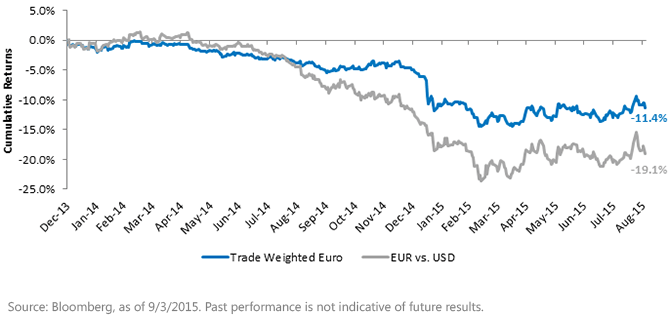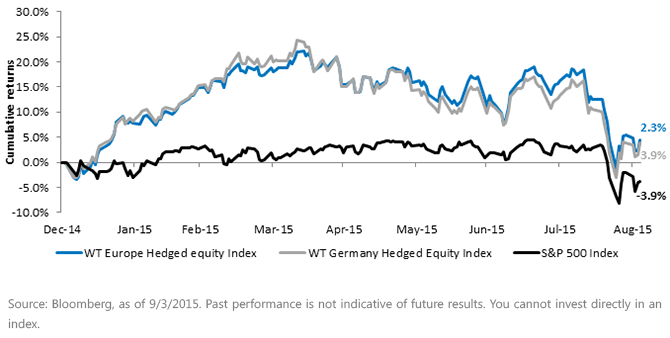Draghi’s Verbal Intervention: Euro Falls and Stocks Rise


 While everyone focuses on the euro versus U.S. dollar cross rate, on a trade-weighted basis the euro has not depreciated anywhere near as much over last year. While the euro is down approximately 20% from the start of 2014, on a trade-weighted basis that depreciation is just 11%.3
The markets reacted positively to Draghi’s news: broad European indexes were up around 2%, while the euro fell 1%.4 This shows a developing negative correlation between the euro and the European equity markets, very much as has been the case for the Japanese equity markets over the past few years.
At one stage earlier this year, both European and German equity markets were up almost 25% on the initial announcement of the QE program in January. These two markets actually dipped into negative territory for the year—taking into account the August volatility—and are only barely positive following the latest ECB announcement. To be fair, European markets are performing better than U.S. markets, which were down almost 4% year-to-date.
Volatility in European Equities
While everyone focuses on the euro versus U.S. dollar cross rate, on a trade-weighted basis the euro has not depreciated anywhere near as much over last year. While the euro is down approximately 20% from the start of 2014, on a trade-weighted basis that depreciation is just 11%.3
The markets reacted positively to Draghi’s news: broad European indexes were up around 2%, while the euro fell 1%.4 This shows a developing negative correlation between the euro and the European equity markets, very much as has been the case for the Japanese equity markets over the past few years.
At one stage earlier this year, both European and German equity markets were up almost 25% on the initial announcement of the QE program in January. These two markets actually dipped into negative territory for the year—taking into account the August volatility—and are only barely positive following the latest ECB announcement. To be fair, European markets are performing better than U.S. markets, which were down almost 4% year-to-date.
Volatility in European Equities
 For definitions of indexes in the chart, visit our glossary.
I believe the more dramatic sell-off in many of these European markets offers an opportunity. Valuations have come down, and there is no less of a commitment from the European Central Bank to support the economic environment. While there are risks from the emerging market economies and China in particular—which is a big market for such European exporters as Germany—I see a continued weakening of the euro that will help their competitive positioning.
As Draghi made clear: There are no limits to the possibilities in the ECB’s gearing up monetary policy if its objectives are not met. And while the Fed may actually hike interest rates next week, the ECB just emphasized the divergent policies that are impacting exchange rates.
Valuation indicators such as European dividend yields versus bond yields are reading at levels that have rarely been hit in the last century, with rates of more than 200 basis points higher on European dividend yields than on bond yields.
European equities—with a hedge to mitigate any currency volatility and weakness—should remain a focal point and over-weight for investors in global portfolios.
1Mario Draghi, ECB, Introductory statement to the press conference, 9/3/15.
2Source: Bloomberg, as of 9/3/15.
3Source: Bloomberg, as of 9/3/15.
4Source: Bloomberg, as of 9/3/15.
For definitions of indexes in the chart, visit our glossary.
I believe the more dramatic sell-off in many of these European markets offers an opportunity. Valuations have come down, and there is no less of a commitment from the European Central Bank to support the economic environment. While there are risks from the emerging market economies and China in particular—which is a big market for such European exporters as Germany—I see a continued weakening of the euro that will help their competitive positioning.
As Draghi made clear: There are no limits to the possibilities in the ECB’s gearing up monetary policy if its objectives are not met. And while the Fed may actually hike interest rates next week, the ECB just emphasized the divergent policies that are impacting exchange rates.
Valuation indicators such as European dividend yields versus bond yields are reading at levels that have rarely been hit in the last century, with rates of more than 200 basis points higher on European dividend yields than on bond yields.
European equities—with a hedge to mitigate any currency volatility and weakness—should remain a focal point and over-weight for investors in global portfolios.
1Mario Draghi, ECB, Introductory statement to the press conference, 9/3/15.
2Source: Bloomberg, as of 9/3/15.
3Source: Bloomberg, as of 9/3/15.
4Source: Bloomberg, as of 9/3/15.
Important Risks Related to this Article
Investments in currency involve additional special risks, such as credit risk and interest rate fluctuations.
Investments focused in Europe increase the impact of events and developments associated with the region, which can adversely affect performance.

Jeremy Schwartz has served as our Global Chief Investment Officer since November 2021 and leads WisdomTree’s investment strategy team in the construction of WisdomTree’s equity Indexes, quantitative active strategies and multi-asset Model Portfolios. Jeremy joined WisdomTree in May 2005 as a Senior Analyst, adding Deputy Director of Research to his responsibilities in February 2007. He served as Director of Research from October 2008 to October 2018 and as Global Head of Research from November 2018 to November 2021. Before joining WisdomTree, he was a head research assistant for Professor Jeremy Siegel and, in 2022, became his co-author on the sixth edition of the book Stocks for the Long Run. Jeremy is also co-author of the Financial Analysts Journal paper “What Happened to the Original Stocks in the S&P 500?” He received his B.S. in economics from The Wharton School of the University of Pennsylvania and hosts the Wharton Business Radio program Behind the Markets on SiriusXM 132. Jeremy is a member of the CFA Society of Philadelphia.

